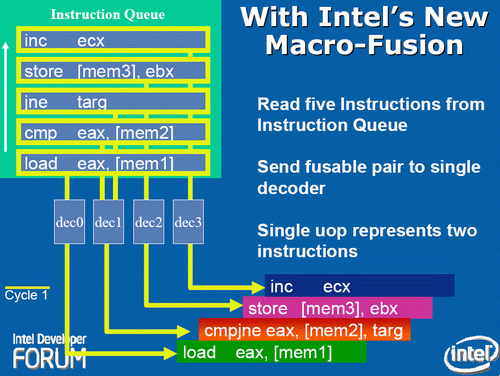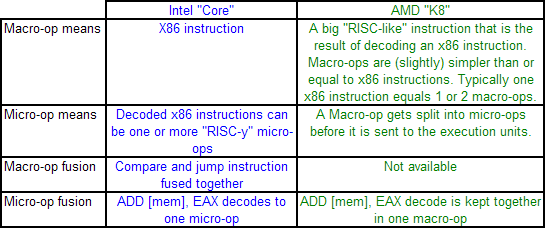Smarter Decoding
Similar to the K8 architecture, Core pre-decodes instructions that are fetched. Pre-decode information includes instruction length and decode boundaries.A first for the x86 world, the Core architecture is equipped with four x86 decoders, 3 simple decoders and 1 complex decoder. The task of the decoders - for all current x86 CPUs - is not only to decipher the incoming instruction (opcode, addresses), but also to translate the 1 to 15 byte variable length x86 instructions into - easier to schedule and execute - fixed length RISC-like instructions (called micro-ops).
The most common x86 instructions are translated into a single micro-op by the 3 simple decoders. The complex decoder is responsible for the instructions that produce up to 4 micro-ops. The really long and complex x86 instructions are handled by a microcode sequencer. This way of handling the complex most CISC-y instructions has been adopted by all modern x86 CPU designs, including the P6, Athlon (XP and 64), and Pentium 4.
There is still more to the Core decoders. The first clever technique is macro-op fusion. It makes it possible for two relatively common x86 instructions to be fused into a single instruction. For example, the x86 compare instruction (CMP) is fused with a jump (JNE TARG). These instructions are typically the assembler result of a compiled if-then-else statement.

The result is that on average in a typical x86 program, for every 10 instruction, two x86 instructions (called macro-ops by Intel) are fused together. When two x86 instructions are fused together, the 4 decoders can decode 5 instructions in one cycle. The fused instruction travels down the pipeline as a single entity, and this has other advantages: more decode bandwidth, less space taken in the Out of Order (OoO) buffers, and less scheduling overhead. If Intel's "1 out of 10" claims are accurate, macro-ops fusion alone should account for an 11% performance boost relative to architectures that lack the technology.
The second clever technique already exists in the current P-M CPUs. There are a few x86 instructions which are pretty complex to perform, but which are at the same time a very typical and common x86 instruction. We are talking for example about mathematical operations where an address is referenced instead of a register. One common example is ADD [mem], EAX . This means add the content of register EAX to the content of a certain memory location (i.e. store the result back at the memory address). Store instructions which get broken down into store address and store data are another example.
In earlier designs such as the P6 (Pentium Pro, PII, PIII) architecture, these instruction would have been broken up into two or even three micro-ops. Remember that the whole philosophy behind all modern x86 CPUs, since the P6, is to decode x86 instructions into RISC-y micro-ops which are then fed to a fast RISC backend; the backend then schedules, issues, executes and retires the instructions in a smooth RISC way.
There is no way you could feed such an instruction (ADD [mem], EAX) to RISC execution units. It violates every RISC rule. RISC designs all load their data into the registers and then perform the necessary calculation on the registers.
So ADD [mem], EAX is broken down into:
Load the contents of [mem] into a register (Since Banias, the ALU and the Load operation are kept together in one micro-op. This is called micro-op fusion. This is no small feat: in older designs keeping the load and ALU operation together would result in pipeline stages that take much longer and thus lower the maximum clock frequency. (In CPU designs, the maximum clock speed is essentially determined by the slowest possible pipeline stage execution time.) Only by using bigger, smarter circuitry that can do a lot in parallel is micro-op fusion possible without lowering the clock speed significantly.MOV EBX, [mem])
An ALU operation, ADD the two registers together (ADD EBX, EAX)
Store the result back to memory (MOV [mem], EBX)
The pre-decode stage recognizes the macro-ops (or x86) instructions that should be kept together. In the decoding phase, ADD [mem], EAX results in one micro-op. Again, this means that the CPU can stuff more instructions in the same OoO buffers, increasing efficiency and improving performance.
Core versus Hammer: Decoding
All very nice, but let us take a look at what really matters: How do the 3 simple + 1 complex decoders of Core compare to the 3 complex decoders of AMD's K8 architecture?The original Athlon ("K7") has two way of decoding, Vector and Direct Path. The Vector Path decoding results in more than two RISC-like instructions (called "macro-ops" by AMD), the Direct Path in one, sometimes two macro-ops. Each of the decoders in K7 can handle both Vector Path and Direct Path decoding, but from a performance standpoint Direct Path is preferred since it results in fewer macro-ops. If you're wondering why were discussing K7 all of a sudden, just as Core is largely based off the P6 architecture, K8 is largely based off the K7 architecture.
The 3 complex decoders are powerful and can decode most x86 instructions, with few instructions requiring the Vector Path. The only downside of the K7 decoders is that some FP instructions and SSE instructions have to pass through the Vector Path. K8 has even stronger complex decoders and almost all FP and SSE instructions are also now decoded through the Direct Path decoders. This is possible as fetching and decoding takes more stages than it did in the K7; the K8 architecture is clearly more powerful when it comes to SIMD.
Obviously, Intel's Macro-op ( x86 instruction ) fusion does not exist in AMD's K8. However, micro-op fusion is available in another form. If we compare Intel's and AMD's macro-ops and micro-ops, it is easy to get confused. Take a look at the table below which explains the differences.

Micro-op fusion does exist in the Athlon. An ADD [mem], EAX is kept together in one macro-op as it travels through the pipeline. Therefore it will take only one place in the OoO buffers. However, the load and execute SSE/SSE2 operations can be fused on Core, while this is not the case on K8: packed SSE operations result in two macro-ops.
So how do Intel's Core and AMD's Hammer compare when it comes to decoding? It is hard to say at the moment without access to Intel's optimization manuals. However, we can get a pretty good idea. In almost every situation, the Core architecture has the advantage. It can decode 4 x86 instructions per cycle, and sometimes 5 thanks to x86 fusion. AMD's Hammer can do only 3.
The situation where AMD's 3 complex decoders can outperform Core's 1 complex + 3 simple decoders is much less likely to happen. It would happen when 3 instructions would be fetched that would have to be handled by the complex decoder of the Core CPU, but which are not too complex that the Microcode Sequencer must kick in. Since the most used x86 instructions all map to one Intel micro-op, this is pretty unlikely.










87 Comments
View All Comments
thestain - Friday, May 5, 2006 - link
Larger Cache and an extra decoder were bound to help Conroe in the small and simple tesing done by most benchmarks.But, what about applications that are a bit larger than Conroe's cache size or those that are complex causing the simple decoders to not be able to be used that much while placing the single complex decoder on the Conroe into short supply?
Mike
IntelUser2000 - Friday, May 5, 2006 - link
LOL. You crack me up. Go see how much doubling of L2 caches help to increase performance. I guess the last 5 years of Netburst screwed people's mental abilities. Sure the caches will help Conroe, but if the CPU doesn't really need the extra cache, then it will be a waste. Kinda like how doubling L2 caches on Pentium D doesn't help a lot. Kinda like how doubling L2 caches on Athlon 64's don't help either. It's why Semprons excel.
About decoders. Guess you are still in the old ages where one of the reasons K7 was better than P6 was because it has the ability to decode complex instructions in all decoders. If you read about Conroe, more of the instructions that USED to go to the complex decoders can now go to the simple decoders.
And which benchmark would that be.
Guess there is gonna be a lot of AMD fanboys that are gonna cry when Conroe is shown.
stopkidding - Tuesday, May 2, 2006 - link
Did anyone notice that this comment thread is virtually free of the usual "Intel-this, AMD-that" comments that usually are seen on this site. The "fanbois" have nothing to bitch about as their little brains can't comprehend whats written in this article! :-)Reynod - Wednesday, May 3, 2006 - link
Which is a sigh of relief I must say. I can swallow hard facts and interpret code ... my 4400+ looks like going in as my new server box ... and my next gaming box looks like being an OC'd Conroe. I just won't buy an Intel Mobo ... heh heh.mino - Tuesday, May 2, 2006 - link
IMHO not, the article is extremely well written AND there are NO benchmarks => Intelman is happy from the text; AMD-man is hoping the real numbere won't be so bad...On topic, article is written in a very good style for general public.
On thing I'am afraid of is the moment code is optimized for Core, any other irchitecture would take a performance hit. K8 the smallest one, PM/K7 the small one, P4/P6 the big one and all older plus C7 e pretty huge hits.
That bothers me.
Except that, AMD will live for a long time (Opteron alone would survive them for 5+ yrs.) and X2's will be finally cheaper. What else to pray for :)
Best regards.
mino - Tuesday, May 2, 2006 - link
addennum:"the article is extremely well written FOR GENERAL AT AUDIENCE"
Otherwise job well done Johan.
nullpointerus - Tuesday, May 2, 2006 - link
Right, but then why do they respond to the other articles?JustAnAverageGuy - Tuesday, May 2, 2006 - link
Another top notch article, as always, Johan- JaAG
dguy6789 - Tuesday, May 2, 2006 - link
Thank you for writing this article. You have cleared up a large quantity of questions that I had in relation to the Core architecture.Betwon - Tuesday, May 2, 2006 - link
sub eax,[edi+ebx+79]There are 3 registers used: eax, edi, ebx
For Core duo, it decodes to one fusion-micro-op.
In the reservation station (RS), only one entry is needed to be allocated. There are three registers spaces in one RS entry at least. And the results of address(edi+ebx+79) can be w rited back into the same position of one register in this RS entry.(A replace method)
For K7/K8, it decodes to one macro-op?
In the reservation station (RS), only one entry is needed to be allocated? There are three registers spaces in one RS entry?
It can take one entry in ROB.
But I don't believe AMD. It may take two entrys in RS, because there are only two registers spaces in one RS entry of K8. K8 hasn't three registers spaces in one RS entry.
K8's RS is up to 8X3 macro-op, but not means that one macro-op can always take one entry in the RS.
I say that I don't believe AMD.
Of course, Other people have on need to believe me too.